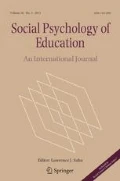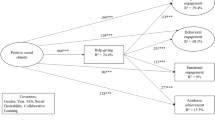Abstract
This study examined the relationship between student perceptions of school efforts to facilitate student involvement, school commitment, self-determination skills, and ontrack indicators for graduation in 10th grade and actual graduation outcomes two years later. The participants were 154 primarily minority students in a large, urban school district. Student perceptions of higher levels of school efforts to facilitate student involvement was related to an increased likelihood that students had passed a state high stakes assessment and were on-track for graduation at the end of 10th grade and an increased likelihood of actual graduation. Implications for facilitating student involvement in educational planning are discussed.
Similar content being viewed by others
References
Alexander, K., Entwistle, D., & Kabbani, N. (2001). The dropout process in life course perspective: Early risk factors at home and school. Teachers College Record, 103, 760–823.
Almqvist, L., & Granlund, M. (2005). Participation in school environment of children and youth with disabilities: A person-oriented approach. Scandinavian Journal of Psychology, 46, 305–314.
Appleton, J., Christenson, S., & Furlong, M. (2008). Student engagement with school: Critical conceptual and methodological issues of the construct. Psychology in the Schools, 45, 369–386.
Benz, M., Lindstrom, L., & Yovanoff, P. (2000). Improving graduation and employment outcomes of students with disabilities: Predictive factors and student perspectives. Exceptional Children, 66(4), 509–529.
Blackorby, J., & Wagner, M. (1996). Longitudinal postschool outcomes of youth with disabilities: Findings from the national longitudinal study. Exceptional Children, 62(5), 399–414.
Bond, T., & Fox, C. (2001). Applying the rasch model: Fundamental measurement in the human sciences. New Jersey: Lawrence Erlbaum Associates.
Carter, E., Wehby, J., Hughes, C., Johnson, S., Plank, D., Barton-Arwood, S., et al. (2005). Preparing adolescents with high-incidence disabilities for high stakes testing with strategy instruction. Preventing School Failure, 49(2), 55–64.
Christle, C., Jolivette, K., & Nelson, M. (2007). School characteristics related to high school dropout rates. Remedial and Special Education, 28(6), 325–339.
Clark, M. A., Lee, S. M., Goodman, W., & Yacco, S. (2008). Examining male underachievement in public education. NASSP Bulletin, 92(2), 111–132.
Connell, J., Halpern-Felsher, B., Clifford, E., Crichlow, W., & Usinger, P. (1995). Hanging in there: Behavioral, psychological, and contextual factors affecting whether African American adolescents stay in high school. Journal of Adolescent Research, 10(1), 41–63.
Deci, E., & Ryan, R. (1985). Intrinsic motivation and self-determination in human behavior. New York: Plenum Press.
deFur, S. (2002). Education reform, high-stakes assessment, and students with disabilities. Remedial and Special Education, 23(4), 203–211.
Finn, J. (1989). Withdrawing from school. Review of Educational Research, 59(2), 117–142.
Fisher, D., Frey, N., & Lapp, D. (2011). Focusing on the participation and engagement gap: A case study on closing the achievement gap. Journal of Education for Students Placed At Risk, 16, 56–64.
Florida Department of Education. (2006). LEA Profile (Technical report). Tallahassee, FL: Author.
Florida Department of Education. (2007, February). Change, and Response to Change, in Florida Public Schools (Technical report). Tallahassee, FL: Author.
Florida Department of Education. (2010). K-12 Comprehensive Research Based Reading Plans, District: Dade (Technical report). Tallahassee, FL: Author.
Fore, C, I. I. I., & Riser, S. (2005). Promoting maintenance and generalization through cognitive decision making training. Journal of Instructional Psychology, 32(2), 127–136.
Gaumer Erickson, A., & Morningstar, M. (2009). The impact of alternate high school exit certificates on access to postsecondary education. Exceptionality, 17, 150–163.
Geenen, S., Powers, L., Hogansen, J., & Pittman, J. (2007). Youth with disabilities in foster care: Developing self-determination within the context of struggle and disempowerment. Exceptionality, 15(1), 17–30.
Gibson, M., & Bejinez, L. (2002). Dropout prevention: How migrant education supports Mexican youth. Journal of Latinos and Education, 3, 155–175.
Green, S., & Salkind, N. (2005). Using SPSS for windows and macintosh: Analyzing and understanding data. New Jersey: Pearson Prentice Hall.
Greene, J., & Winters, M. (2002). Public school graduation rates in the United States. Civic Report (31). Manhattan Institute for Policy Research.
Hartman, J., Wilkins, C., Gregory, L, Gould, L., & D’Souza, S. (2011). Applying an on-track indicator for high school graduation: Adapting the Consortium on Chicago School research indicator for five Texas districts. REL 2011-No.100: Institute of Education Sciences.
Jenkins, P. (1995). School delinquency and school commitment. Sociology of Education, 68(3), 221–236.
Knesting, K., & Waldron, N. (2006). Willing to play the game: How at-risk students persist in school. Psychology in the Schools, 43, 599–611.
Kortering, L., & Braziel, P. (1999). School dropout from the perspective of former students. Remedial and Special Education, 20(2), 78–83.
Kortering, L., & Braziel, P. (2008). Engaging youth in school and learning: The emerging key to school success and completion. Psychology in the Schools, 45(5), 461–465.
Kortering, L., & Christenson, S. (2009). Engaging students in school and learning: The real deal for school completion. Exceptionality, 17, 5–15.
Lee, V., & Burkham, D. (2003). Dropping out of high school: The role of school organization and structure. American Educational Research Journal, 40(2), 353–393.
Lehr, C. A., Hansen, A., Sinclair, M. F., & Christenson, S. L. (2003). Moving beyond dropout prevention to school completion: An integrative review of data-based interventions, School Psychology Review, 32(3), 342–364.
Levesque, C., Zuehlke, N., Stanek, L., & Ryan, R. (2004). Autonomy and competence in German and U.S. university students: A comparative study based on self-determination theory. Journal of Educational Psychology, 96(1), 68–84.
Levin, H., Belfield, C., Muening, P., & Rouse, C. (2007). The costs and benefits of an excellent education for all of America’s children. New York: Teacher’s College.
Lubbers, J., Repetto, J., & McGorray, S. (2008). Perceptions of transition barriers, practices, and solutions in Florida. Remedial and Special Education, 29(5), 280–292.
Mason, C., Field, S., & Sawilowsy, S. (2004). Implementation of self-determination activities and student participation in IEPs. Exceptional Children, 70(4), 441–451.
Montague, M., Enders, C., Dietz, S., Morrison, W., & Dixon, J. (2008). A longitudinal study of depressive symptomology and self-concept in adolescents. Journal of Special Education, 42, 67–78.
Morrison Cavendish, W. (2009). The no child left behind act and high school graduation for students with and without disabilities. In T. E. Scruggs & M. A. Mastropieri (Eds.), Policy and practice: Advances in learning and behavioral disabilities (Vol. 22). Bingley, UK: Emerald.
National Assessment of Educational Progress. (2007). The Nation’s Report Card. Retrieved on March 27, 2009 from http://nces.ed.gov/nationsreportcard/
National Center for Education Statistics (NCES): ELS 2002. (2009). Statistics in brief: Course credit accrual and dropping out of high school, by student characteristics. Washington, D.C.: Author.
Patrick, H., Ryan, A., & Kaplan, A. (2007). Early adolescents’ perceptions of the classroom social environment, motivational beliefs, and engagement. Journal of Educational Psychology, 99(1), 83–98.
Quality Counts. (2011). Retrieved on January 13, 2011 from http://www.edweek.org/ew/articles/2011/01/13/16execsum.h30.html?intc=ml
Reardon, S., Arshan, N., Atteberry, A., & Kurlaender, M. (2010). Effects of failing a high school exit exam on course taking, achievement, persistence, and graduation. Educational Evaluation and Policy Analysis, 32(4), 498–520.
Romanik, D., & Froman, T. (2008). Research brief: Trends in high school graduation rates. Retrieved April 10, 2009, from http://www.dadeschools.net.
Ryan, R., & Deci, E. (2000). Self-determination theory and the facilitation of intrinsic motivation, social development, and well-being. American Psychologist, 55(1), 68–78.
Sampson, R. & Laub, J. (1993). Crime in the Making Pathways and Turning Points Through Life. Harvard University Press.
Sherer, M., Maddux, J. E., Mercandante, B., Prentice-Dunn, S., Jacobs, B., & Rogers, R. (1982). The Self-Efficacy Scale: Construction and validation. Psychological Reports, 51, 663–671.
Shogren, K., Faggella-Luby, M., Bae, S., & Wehmeyer, M. (2004). The effect of choice-making as an intervention for problem behavior: A meta-analysis. Journal of Positive Behavior Interventions, 6(4), 228–237.
Shogren, K., Wehmeyer, M., Palmer, S., Soukup, J., Little, T., Garner, N., et al. (2007). Examining individual and ecological predictors of the self-determination of students with disabilities. Exceptional Children, 73, 488–509.
Test, D., Fowler, C., White, J., Richter, S., & Walker, A. (2009). Evidence-based secondary transition practices for enhancing school completion. Exceptionality, 17, 16–29.
Wagner, M., Newman, L., Cameto, R., Levine, P., & Marder, C. (2007). Perceptions and expectations of youth with disabilities: A special topic report from the National Longitudinal Transition Study-2. Menlo Park: CA: SRI International.
Wang, M., Willett, J., & Eccles, J. (2011). The assessment of school engagement: Examining dimensionality and measurement invariance by gender and race/ethnicity. Journal of School Psychology, 49, 465–480.
Wehmeyer, M., & Kelchner, K. (1995). The Arc’s self-determination scale. United States: The Arc of the United States.
Wehmeyer, M., Palmer, S., Agran, M., Mithaug, D., & Martin, J. (2000). Promoting causal agency: The self-determined learning model of instruction. Exceptional Children, 66(4), 439–45.
Wehmeyer, M. L., Yeager, D., Bolding, N., Agran, M., & Hughes, C. (2003). The effects of self- regulation strategies on goal attainment for students with developmental disabilities in general education classrooms. Journal of Developmental and Physical Disabilities, 15, 79–91.
Wehmeyer, M., Field, S., Doren, B., Jones, B., & Mason, C. (2004). Self-determination and student involvement in standards-based reform. Exceptional Children, 70(4), 413–426.
Wehmeyer, M., Abery, B., Zhang, D., Ward, K., Willis, D., Hossain, W., et al. (2011). Personal self-determination and moderating variables that impact efforts to promote self-determination. Exceptionality, 19, 19–30.
Wu, J., Hughes, J., & Kwok, O. (2010). Teacher-student relationship quality type in elementary grades: Effects on trajectories for achievement and engagement. Journal of School Psychology, 48, 357–387.
Ysseldyke, J., Nelson, J., Christenson, S., Johnson, D., Dennison, A., Treiezenberg, H., et al. (2004). What we know and need to know about the consequences of high- stakes testing for students with disabilities. Exceptional Children, 71(1), 75–94.
Author information
Authors and Affiliations
Corresponding author
Rights and permissions
About this article
Cite this article
Cavendish, W. Student perceptions of school efforts to facilitate student involvement, school commitment, self-determination, and high school graduation. Soc Psychol Educ 16, 257–275 (2013). https://doi.org/10.1007/s11218-013-9212-z
Received:
Accepted:
Published:
Issue Date:
DOI: https://doi.org/10.1007/s11218-013-9212-z




